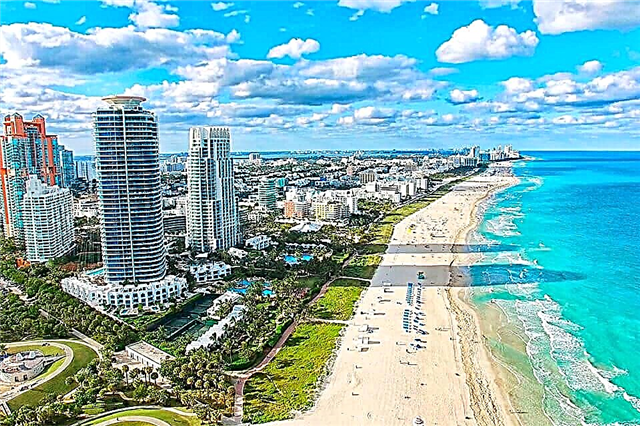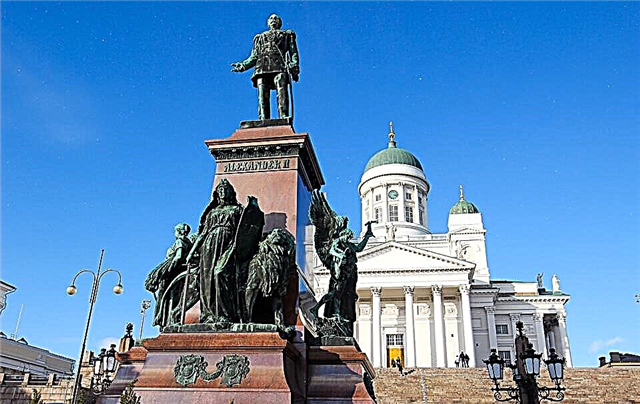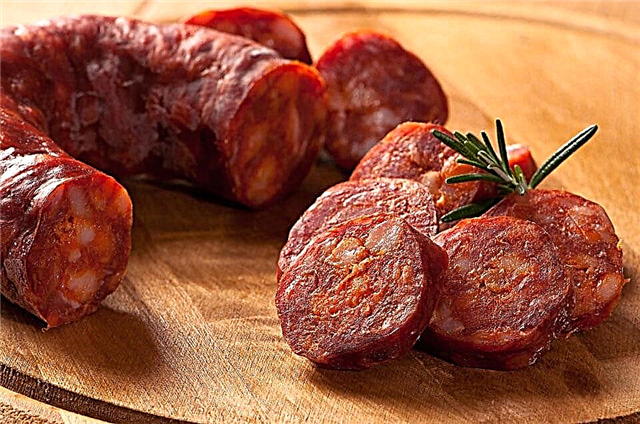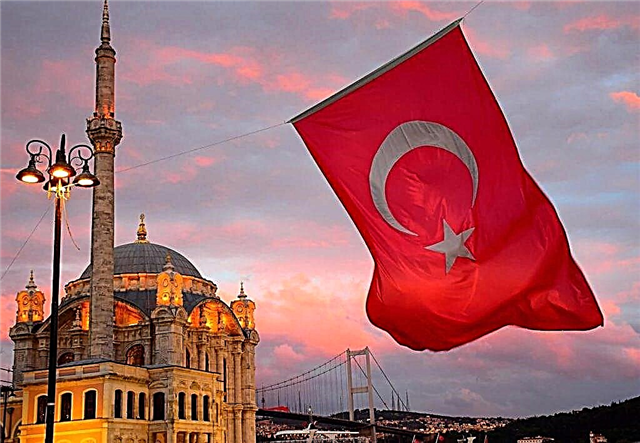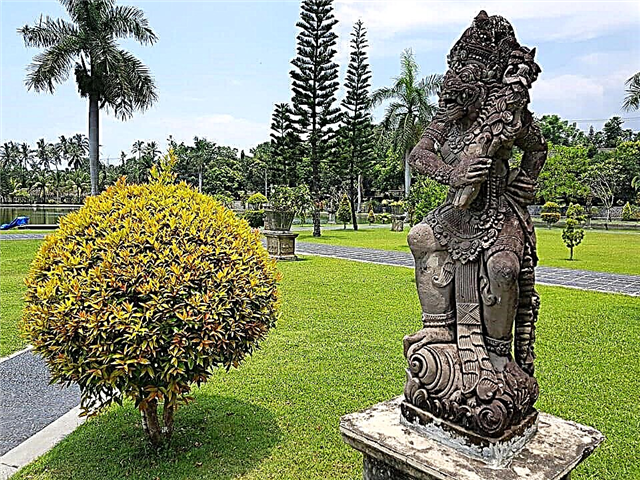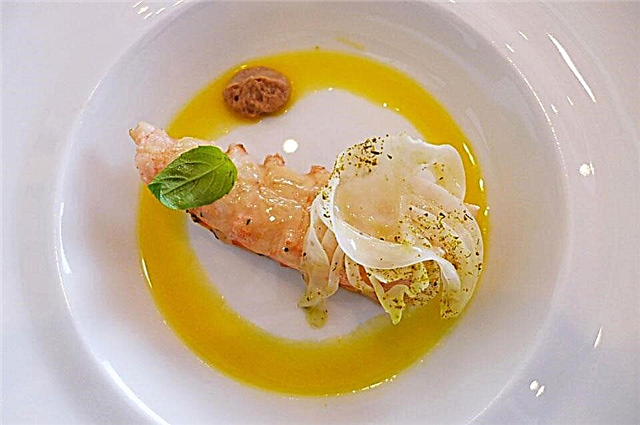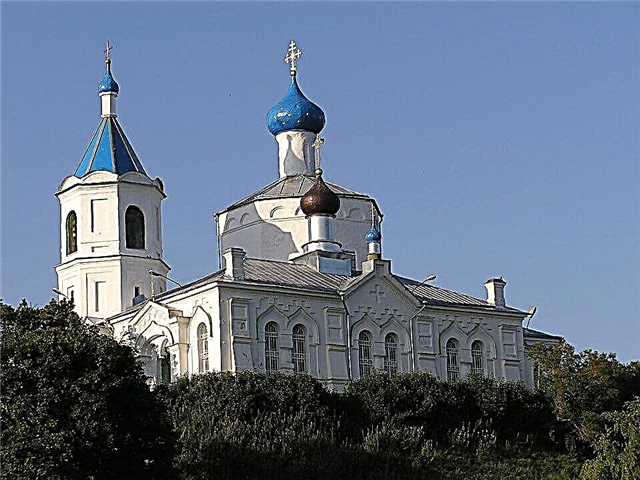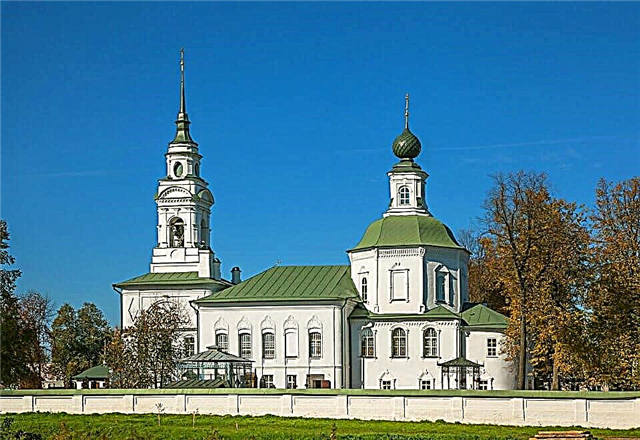Kostroma is a precious pearl set in the Golden Ring of Russia. The history of the ancient Russian city dates back to the 12th century, when it began to be built on the high picturesque bank of the Volga River. Over the past centuries, many events that were significant for the formation of the Russian state took place behind its fortress walls. Here in the Ipatiev Monastery in the Time of Troubles the future Tsar Mikhail Romanov was saved and Ivan Susanin performed his feat. Having survived several fires in its history, the city was rebuilt again, acquiring the unique flavor of the Russian merchant city at the end of the 18th century, which has now become the center of ethnographic and religious tourism. The sights of Kostroma captivate tourists, transferring them to the atmosphere of the 18-19 centuries, when the city was experiencing its heyday.
Shopping arcade
As a rule, acquaintance with the sights begins with the Shopping Rows, located a few blocks from the Susanin Square to the site of the former Kremlin. This old shopping complex with numerous shops and warehouses is recognized as a valuable urban planning monument. Its construction began after a fire in 1775 by the famous architect Karl von Kler. The center of the Trading Rows is two opposite buildings, built in the tradition of late classicism - Gostiny Dvor with 86 rooms (Red Rows) and the Bolshoi Flour Rows building.
The people called the red ranks where they traded in fabrics, furs, footwear, and leather goods. You will see two similar squares with rounded corners on the outside and spacious courtyards. Entering the Red Rows, you will see 4 one-story buildings that harmoniously fit into the outer buildings. They were built in the 20-30s of the 20th century for merchant shops selling haberdashery goods, giving them the name Melochnye Ryadi.
Outside, the shopping arcade seems small, but as soon as you enter the arch of the Gostiny Dvor, you will immediately find yourself in a large trading city with its own "streets", where others appear behind some buildings. And, as in the old days of the merchant scale, today in the Trade Rows there is a brisk trade in goods for which the region is famous. You can visit the shopping arcade at any time of the day.
The central entrance is from Krasnye Ryady Street, 1.
Central park
Tired of walking along the Torgovye Ryady Street, it's time to walk along Tabachny Ryady Street to the Volzhskaya Embankment, from where the Central Park is just a stone's throw away. It is located in the northern part of the former Kostroma Kremlin. Today the park is a favorite resting place for the townspeople. A monument to V.I. Lenin.
The fact is that the figures of Kuzma Minin, Dmitry Pozharsky and Ivan Susanin should have stood on this pedestal, but the monument was not completed before the 1917 revolution. This is how the leader of the proletariat appeared on the pedestal. Walk to the observation deck built on the remains of the Kremlin wall for stunning views of the Volga and Volga pier. From the park to the pier, you can walk along a stone path, going down a beautiful staircase.
On the territory there are original benches with the city's coat of arms, and there is also the only unique bench - Reconciliation. According to local tradition, it is always visited by newlyweds, as well as spouses who want to make peace after a quarrel. The park has several carousels and attractions, a children's railway. The main entrance to it is from the side of Chaikovskogo Street.
Ostrovsky's gazebo
A stunning view of the city panorama and the Volga bank opens from the Ostrovsky pavilion, flaunting on a high embankment left from the former fortress. The gazebo, which became the symbol of the city, was built in 1956, much later, the famous playwright, who loved to relax in this place, drawing inspiration. The erected white stone gazebo appears in the traditional 19th century garden architecture of such buildings, which were in many Russian noble estates.
It consists of seven columns covered with a roof. This gazebo became famous all over the country, for the filming of the film "Cruel Romance" based on the play "The Dowry" by Alexander Ostrovsky. The attraction is located near May 1 street.
Fire Tower
The Fire Tower, towering on Susaninskaya Square, has become a significant symbol since its construction. This is a real architectural monument of the late 18th and early 19th centuries, harmoniously fitting into the architectural ensemble of the area. The majestic stone building looks like an antique temple with Corinthian columns, 6 porticos, with fire stations at their edges.
In the center of the triangular pediment there is a high relief of a two-headed eagle. The tower building consisted of living quarters, sheds for cars and barrels of water. Above the main building there was an observation tower, where from a height of 35 meters a sentry watched the fire situation in the city and, at the sight of a fire center, rang a bell and launched balloons, announcing the place of fire.
A red ball meant a fire in the center, and a blue one on the outskirts. At night, they announced signal lights - white and red. The building of the Fire Tower is included in the UNESCO World Heritage List and is under state protection. Now the Museum of Firefighting is open in it, which is open from Monday to Friday from 10.00 to 16.00. Days off Saturday and Sunday.
Guardhouse
The stone building of the guardhouse on Susaninskaya Square, built in the early 19th century in the Empire style, was built to keep arrested soldiers in custody. Famous historical personalities had to visit its walls: Decembrists, Narodnaya Volya and Polish rebels. The one-story building with columns and mezzanines at the top attracts the eye with its elegant facade with decorative and thematic stucco decorations, reminiscent of the victories of the Russian people over Napoleon.
Skillfully executed: a composition with an angel supporting the royal monogram, military shields and ammunition. The windows are decorated with beautiful snow-white decor. The historical and cultural monument of the guardhouse is in the status of the cultural heritage of the state. Today it houses a museum of military history.
Its halls display unique exhibits of weapons that were fought in different historical eras. You will see different samples of sabers and daggers, revolvers and rifles. Military uniforms, chain mail, helmets, shields are of great interest. No less interesting is the extensive collection of orders, medals, banners and historical documents. Visitors can take pictures in military uniform and with weapons.
Borshchov House
In the architectural ensemble of Ivan Susanin Square, the House of Senator Borshchov stands out, more reminiscent of a palace mansion. Without exaggeration, it can be called a monument of the Kostroma architecture of late classicism. The imposing, colonnaded building was one of the city's largest estates from the first quarter of the 19th century. The main facade overlooking the square is a two-story mansion with a mezzanine, decorated in the center with a portico of the Corinthian order. The presence of powerful columns erected on the ledge of the lower floor with an arcade and a figured lattice make the building especially stately.
Large oval windows between the columns and rich stucco decoration give a grand look to the mansion. The interior of the house is remarkable for 2 large halls. They have preserved stoves lined with white tiles, paneled doors and stucco ceiling cornices. The design of the main staircase with cast-iron steps and railing posts made of curls is amazing. The district court is now located in the historic building, so it is not possible to see its interior.
Assembly of the nobility
The collection of the nobility is a museum housed in a building in the style of late classicism. It was built in 1780 as a residential building, and later in the 30s of the 19th century, during the reconstruction according to a special project, it was completed with a southern wing with a spacious bright hall intended for the Noble Assembly.
After the reconstruction, the building acquired a form that has survived to this day - with front entrances, facade decor and a luxurious cast-iron staircase inside. Along the openwork steps of the main staircase, decorated with railings with bronze decor, go up to the second floor, where the White and Small Halls are located. The perimeter of the walls of the White Hall is decorated with Corinthian columns arranged in two tiers, faced with white artificial marble, like the walls of the hall.
The luxurious design of the Small Hall with columns that divided it into three parts and the ceiling decorated with coffered gilded rosettes amazes you. The hall is elegantly decorated with red silk damask in the decoration of the walls and white marble pilasters. In these luxurious halls, you will plunge into the world of interesting provincial stories, the life of the nobles and the population of the city, elections of the leaders of the nobility, provincial balls.
It is located at 7 Mira Street and is open daily from 11.00 to 19.00.
House of Rogatkin and Botnikov

The three-storey house of Rogatkin and Botnikov complements the architectural ensemble of Susanin Square. It is named after the names of the former owners who occupied half of the house. One part, from the side of Susanin Square and Mira Street, belonged to the merchant Rogatkin, and the second part, from the side of the present Lenin Street, belonged to his father-in-law, the tradesman Botnikov. The construction of the building took place at the beginning of the 19th century and has undergone minor changes to this day.
In its architectural form, the mansion is shaped like the letter "G" with rounded corners. If we enter from the side of Lenin Street, we will see the facade, clearly divided by interfloor cornices in the form of shelves with decor in the form of massive wedge locks on the windows of the first floor. On the front second floor, the framing of the windows is distinguished by intricate platbands.
The entrance from Lenin Street is equipped with a figured cast-iron porch with a canopy. The two rounded corners of this half of the house are distinguished by balconies on brackets with patterned trellises. Opposite - the eastern part of the facade is more restrained in decor. A modest entrance from the side of Mira Street is decorated in the form of a small metal umbrella. At different times, there were hotels, restaurants and entertainment establishments here. The house can only be viewed from the outside.
Epiphany-Anastasiin Monastery
The foundation of the Epiphany-Anastasia monastery falls on 1559, but today we see it in the architecture of the 17th century after the restoration work caused by the destruction of the Time of Troubles. On the territory of the convent of interest for tourists is the unique architecture: the Epiphany Cathedral, dating back to 1559, the Epiphany-Anastasin Cathedral, the Church of the Smolensk Icon of the Mother of God, the bell tower.
Immediately upon entering the territory of the monastery, the view of the picturesque bell tower, built in 1864, attracts attention. Its majestic structure is crowned with a tent, which is completed by a gilded dome. Interesting in its architecture of the Russian-Byzantine style is the one-domed church of the Smolensk Icon of the Mother of God with a miraculous fresco icon.
The majestic construction of the white-stone Epiphany Cathedral delights with its facade, completed with graceful keeled zakomaras and shiny gold domes. The temple has four thrones. Pilgrims rush to it to pray to the miraculous image of the Fedorov Mother of God. You can get acquainted with the interior and the shrines in the monastery only in the Epiphany Cathedral and the chapel.
The monastery is located on Simanovskogo street, 26.
Transfiguration Church
The Old Believer Church of the Transfiguration of the Savior is located on the right bank of the city in the former Spasskaya Sloboda. The church building, built in the 80s of the 17th century, has acquired its original five-domed appearance after reconstruction. On the east side, the church houses an altar consisting of 3 parts. The western side is the southern limit with a refectory located in it, crowned with a tent. The temple also has a hipped bell tower. The decor of the four-sided facades attracts with windows framed by rich platbands and entrances decorated with portals.
The facades are completed with a wide cornice with an ornament and semicircular kokoshniks. A relief tile is visible in the lower tier of the bell tower. In the interior of the temple, the 17th century murals of the Kostroma icon painters have been preserved. The church vault is notable for the paintings of the plot, called in the holy scripture "The prisoner vertograd", depicting the apostles going to its gates. On the top row of frescoes under the vault, one can see a festive cycle of 16 compositions. Today the temple is in the status of the Cathedral of the Kostroma and Yaroslavl dioceses. You will find him on Volgary Street. It is open for visits on Saturday from 15.00 to 19.00, Sunday from 7.00 to 11.00.
Terem of the Snow Maiden
If the residence of Father Frost is in Veliky Ustyug, then his granddaughter, the Snow Maiden, has registered in Kostroma and lives in her Terem. The brownies and the cat Bayun live with her. Terem Snegurochka is a cultural complex with a restaurant, a playground, an improvised belfry and other buildings. Boulders with playful signs will keep you from getting lost.
The dwelling of the granddaughter of Grandfather Frost is an old Russian log mansion with 2 floors with platbands decorated with openwork carvings and a veranda. The owner of the old Russian tower will greet her guests with a loaf, introduce them to her assistants and invite them to the parlor. The temperature of -14 ° C is maintained throughout the whole house, so before the excursion, visitors will be given zipuns and felt boots.
After treating the guests in the parlor with drinks from ice cups, they go to the room where there is a magic mirror, with the help of which a teleconference with Santa Claus takes place. Further, guests will see the rooms: Miracles, Yolochnaya and Ice. Those interested can mint commemorative coins, eat traditional Russian cuisine in the Snegurochka restaurant and watch a fascinating performance with the heroes of ancient Slavic mythology. You will find Terem of the Snow Maiden on Lagernaya Street, 38. Guests are welcome here from 10.00 to 18.00.
Church of the Resurrection of Christ on Debra
The Church of the Resurrection on Debra is recognized as an outstanding monument of history and culture of the 17th century. Tourists always come to admire its unusual architecture in the Old Russian style. The cross-domed five-domed church building with three apses stands on a high base and is surrounded on three sides by covered galleries. Multicolored square and rectangular checkers, paired semi-columns and window frames, framed by elegant kokoshniks, give a picturesque look to the church facades.
The temple is lavishly decorated with tiles, stone carvings depicting mythological animals and plants. Two church porches, covered with voluminous tents bordered by double patterned kokoshniks, stand out brightly. The west wing of the gallery is connected to the Holy Gate. Their uniqueness lies in the arched passageways topped with three faceted tents, topped with onions with a cross.
At the Holy Gates, stone carvings against the background of polycolored tiles and four white high reliefs depicting the symbols of the holiday of the Resurrection are admired.
The church is adjoined by a four-tiered bell tower in classical architecture. The interior design of the temple fascinates with the beautiful decoration of the apses, the iconostasis of the 19th century, preserved ancient frescoes and unique icons of the 17th century. You can see this beauty on any day of the week from 7.30 to 20.00. The church is located on Nizhnyaya Debrya Street, 37.
Museum of unique dolls and toys
The museum of unique dolls and toys deserves a visit, which opened in 2013 on the basis of the collection of a local resident, collected for more than 30 years, and is replenished to this day. Two small rooms amaze with their exhibits - toys from all countries. An extensive exhibition gathered old dolls in national and secular clothes - French, Dutch and German. Among them, modern dolls made in Tibet, the islands of Java and Bali also look exotic.
There are many clockwork clowns, bears and other toys, dolls with opening eyes in the exhibition. No less impressive is the collection of toys produced by the Soviet industry - plush, plastic, metal. There are bears, dogs and other animals, various dolls, sets of toy soldiers and all kinds of equipment that helped children adapt to the adult world.
It is located on Gornya street, 26, working seven days a week from 10.00 to 18.00.
Museum of the Kostroma merchant

Kostroma has long been considered a merchant city. It was the merchants who made a huge contribution to its development. In gratitude to this estate, the Kostroma merchant museum was founded. The two-storey building of modern uncomplicated architecture houses interesting exhibitions of rare objects that clearly tell about the way of life, way of life, traditions and spiritual culture of famous merchant families. The museum has three halls.
It recreates a sled yard with various carts and sleds used by merchants and peasants to transport goods in all seasons. In winter, these are horse-drawn sleds, and in summer, carts. You will see examples of outbound sleighs: for a trip to visit and a temple, to a fair and a bazaar, to celebrate Maslenitsa and a wedding. You will find out which sleds were intended for the transportation of goods, called logs and sleds. The museum presents a rarely seen type of sled - races, notable for an open narrow body and intended for departure.
Other halls introduce items of family use and everyday life of the 18-19 centuries. The expositions showcase an extensive collection of teapots, samovars, dishes, irons, furniture, chests, postcards, photographs and other items used in everyday life.
It is located at 36/19 Engels Street and is open to visitors all days of the week, except Monday, from 10.00 to 16.00.
Museum of Jewelry Art
More than a third of gold and silver jewelry is made in this ancient city. The Museum of Jewelry Art, created in 2013, was called to show the achievements and skillful samples of jewelry accumulated over two centuries, the conditions of life and work of the Kostroma and Krasnoselsk jewelry masters of the past years.
The collection contains almost 1000 samples of jewelry in different styles and different times, from the 18th century to the present day. Among them are products, both handicraft made by craftsmen, and jewelry made by jewelry factories. A unique part of the collection is graceful adornments that delight with the filigree execution of lace patterns, the finest local technique "Krasnoselskaya filigree". In a separate exposition, you can see the tools of jewelers - old and modern, as well as the restored pre-revolutionary workshop of jewelers.
It is located in an old building on Sovetskaya Street, 7, working on Wednesday, Friday - Sunday from 11.00 to 18.00, on Thursday from 12.00 to 20.00. Monday and Tuesday are days off.
Museum of Nature of the Kostroma Region
Located in an old building, which is an architectural monument of the 19th century, on Molochnaya Gora. There are almost 1,700 exhibits in thematic expositions. The exposition of the "Mesozoic" epoch, dedicated to the most ancient and mysterious period of the development of the region, is interestingly executed. Here, on the diorama "Sea of the Jurassic", various inhabitants of the sea are shown in full size and the moment of the hunt of a predatory dinosaur up to 4 meters in size. The rich fauna of the region is presented in the "Animals and Birds" exposition.
In addition to common forest dwellers, you will see rare protected animals and birds. The exhibitions dedicated to the seasons "Winter" and "Spring" tell about these periods of the life of local animals and birds in exhibits and dioramas. The collection of butterflies and insects will not leave indifferent nature lovers. It contains more than 4 thousand representatives of the fauna of these species - the inhabitants of Europe, Asia, Africa and America. The "Insectarium" exposition provides an opportunity to observe rare living insects in terrariums. You can admire the beauty of the stones, learn their properties and secrets by examining the "Born by the Earth" exposition.
Address: Molochnaya Gora, 3. Working hours: Monday to Friday from 10.00 to 18.00, Saturday from 10.00 to 19.00, Sunday from 10.00 to 18.00.
Museum "Provincial town of Kostroma"
Founded by local historians in 2014. Located in the Red Rows trade in a separate two-storey building of Melochny Rows, it occupies 4 halls. Today the first hall dedicated to the history of this provincial town and the exposition called "Copper Plastic 10-20" have been opened. This room displays many photographs, posters and specific postcards taken at the turn of the 19th and 20th centuries.
It is interesting to get acquainted with the history of the Trading Rows, publications of the early twentieth century, original documents of merchants and industrialists, banknotes, Kostroma enterprises and many other artifacts. At the exhibition "The Voiced Witness of History" you will learn about the local traditions of bell casting, see 100 unique bells with original sound. The exposition "Copper Plastic 10-20" will attract the attention of old icons and crosses. In addition to the museum of the provincial city, this building houses the Museum of Heraldry and Faleristics with a large collection of badges, badges, emblems and medals.
The opening hours of the expositions: Monday, Wednesday, Friday, Saturday from 11.00 to 17.00. Tuesday, Thursday, Sunday - days off.
Romanov Museum
Near Susaninskaya Square there is a picturesque white house in the form of a tower. This is one of the most popular attractions - the Romanov Museum, built in the Russian Art Nouveau architectural style. Emperor Nicholas II came with his family to the opening of the museum; in memory of his visit, the Tsar's autograph was left in a memorial book. In 2103, the Romanov Museum, which contains historical documents about the ancestors of the ancestor of the house of the Romanovs, Alexei Mikhailovich, celebrated its 100th anniversary. The expositions present a detailed picture of the life of the Kostroma boyars, associated with the intertwining of the fate of the Romanov and Godunov dynasties.
Boyar chambers of the 17th century, weapons and items of boyar life have been recreated here. One of the fascinating exhibitions tells the story of etiquette adopted in Russia in the 19th century. The collection of aristocratic tableware, furniture and clothing will attract attention here. Art lovers will be able to admire hundreds of works of fine art: painting, graphics and sculpture, transferred from the Hermitage.
Address: Prospect Mira, 5. You can visit the exposition daily from 11.00 to 19.00.
Exotarium
An exotarium is an exhibition and educational center founded by a group of enthusiasts, zoologists-terrariumists. It is located in the former House of Trade Unions. Here they keep, study and replenish the collection of rare exotic animals collected from all over the world. Visitors are impressed by the sight and habits of rare snakes, lizards, turtles, tropical frogs, tarantula spiders, various species of parrots and rabbits. A distinctive feature of the work of the exotarium is the reproduction of some species of animals to replenish zoos and the zoological education of young naturalists.
You can look at feeding and caring for animals, as well as various thematic exhibitions. One of the directions of the exotarium was the breeding of insects to feed lizards and snakes kept at home. The exotarium is located at Sovetskaya Street, 53 "B".Open on weekdays from 10.00 to 18.00, on weekends from 10.00 to 19.00.
Amusement Park "On Nikitskaya"
Near the railway station and the hotel complex "Troy" there is a favorite place for year-round recreation of townspeople and tourists - the amusement park "Na Nikitskaya". The park entertainment complex has several play areas, recreation areas, a concert venue, a children's cafe "Terem" and a children's restaurant "Visiting the Fairy Tale". For the entertainment of children and adults, there are several children's, family and extreme attractions.
You can spend exciting leisure time in the trampoline town, swimming in boats and with water balloons in the pool, shooting at a shooting range, recharging adrenaline at the circuit and taking a ride in an electric car. Many visitors choose to spend their leisure time in the Illusion indoor pavilion. In it, children make an exciting journey through the “Fairy Labyrinth”, enjoy spending time in the children's playroom, in the complex of electromechanical rockers and carousels, on the “Rally” and “Air Cannon” attraction. Men come to play billiards, and the whole family can watch a movie in the 4-D cinema.
All year round, amateurs come here to watch cultural and entertainment programs and take part in competitions with the presentation of prizes. The park is located on Nikitskaya Street and is open seven days a week from 10.00 to 23.00.
Memorial of Glory
The greatness of the historical feat of the people in the Great Patriotic War appears in full force in the Memorial of Glory located on Mira Avenue. An alley leads to the memorial complex, in front of the entrance to which there is a rectangular stele with the image of the overlaid order of the Great Patriotic War and the dates of 1941-1945. Further, the gaze opens a monument, towering on the site. Against the background of two white marble slabs, a high pedestal is erected with figures of the Motherland-Mother with a wreath in her hands and a soldier frozen in a minute of silence.
On both sides of the monument there are steles with the inscription “Nobody is forgotten. Nothing is forgotten. " At the base of the monument, on a dark granite slab, lies a bronze star with an unquenchable Eternal Flame. On both sides of the alley on the site, you will see 10 massive slabs with large bronze stars. On another sculptural composition of the memorial, the figure of a warrior with a hand raised in a rush with a submachine gun, rescuing a teenage boy, froze. The names of 886 warriors buried here are carved in gold letters on the pedestal of the monument. The Glory Memorial is not only a memorial of sorrow, but a memorial to the preservation of peace.
Zoo
The city zoo was founded in 2010 on a picturesque area of the Posad forest with an area of 92.1 hectares. It cannot yet boast of a large number of inhabitants, but every year it is replenished with new species of animals kept in open and closed enclosures. Today in the zoo it is possible to observe the habits of 23 species of animals, and their total number is 58 individuals. Adults and children are happy to come to the zoo to look at the lion, red deer, sika deer, llama, camels.
Besides them, you will see wild boars, wolves, brown bears, lynx, red and black-brown foxes, raccoon dog, mink and feed the frisky squirrels. It is interesting to visually familiarize yourself with the different species of the bird family. Here you will see a proud African ostrich, graceful swans - black and mute swans, species of the order of pigeons, peacocks and pheasants. Urban children are also interested in the behavior of domestic birds - geese, turkeys and mallard ducks. The zoo is located on Lenin Street, you will notice it by the sculptural figures of a bear and a lion, meeting visitors at the entrance.
Open all week: from 10.00 to 20.00 in the summer; in winter - from 10.00 to 17.00
Church of the Savior on Zaprudna

The white-stone Church of the Savior on the Zaprudna River belongs to the historical and cultural monuments of federal significance. It was built in 1754 on the site of a wooden church from the 2nd half of the 13th century. You will see a snow-white two-story church building of the Naryshkinskoye Baroque style in the shape of an octagon, standing on a four-sided structure, completed with an octagonal drum with a dome. A 2-storey meal and a bell tower of the classical style, completed with a spire with a cross, are attached to the temple.
In the interior of the temple and the refectory, the gaze stops at the paintings depicted in the compositions. The main iconostasis resembles a temple in its architectural form. It houses old (16-17 centuries) and later icons, decorated with modern carvings. Each side-altar has its own gilded iconostasis, decorated with pseudo-Russian style carvings. Of particular interest is the necropolis near the temple with artistically executed tombstones from the 18th - early 20th centuries.
The church is located on Zaprudnya street, 2. You can visit any day from 8.00 to 18.00.
Arboretum
Arboretum is an oasis of wildlife in the city, spread over an area of 30 hectares. Numerous varieties of plants and 30 species of trees and shrubs from various climatic zones are grown here in the open field. The healing atmosphere of the park is created by 11 species of coniferous trees, including rare Banks pines, European and blue spruce, fir, cedar. Walking along its paths and paths is not only pleasant, admiring the view of rare plants, but also good for health.
In addition to coniferous trees, pedunculate oaks, sharp-leaved maples, Berlin poplars, Siberian larches, smooth elms and birches grow here. The peculiarity of the arboretum is that a certain area is allocated for each type of trees and shrubs, which makes it possible to see the nature of different climatic zones. There is no infrastructure at all in the Arboretum. On the way to its central part there are 2 lakes surrounded by a picturesque forest. In the summer, they become a favorite vacation spot for the townspeople. The arboretum is located along Lenin Street with the entrance after the intersection with Krasnaya Mayevka Street.
Church of St. John the Evangelist

The temple dedicated to St. John the Theologian belongs to the historical and cultural monuments of federal significance. Its location is the center of the former Ipatievskaya Sloboda. The main building of the church was erected in the 80s of the 17th century, later it was supplemented by a south porch, a brick fence with a gate. Today we see a beautiful two-pillar cathedral crowned with 5 domes, three apses and a hipped-roof bell tower.
Its facades gracefully end with false zakomaras, and the windows attract the eye with ornamented architraves with keeled ends. Admiration for the temple begins with the entrance gate, crowned with a faceted drum with a dome and an arched entrance. The bell tower admires with its rich decor - niches and inserts from green tiles.
The interior of the church is striking in its richness of murals. It is worth looking up, where in the center of the dome is the image of Christ the Almighty. The vaults are decorated with paintings of the Apostles, the Trinity and the Mother of God. On the walls, the cycle of paintings on biblical themes, applied in 4 rows, is fascinating. The iconostasis dating back to the 19th century has been partially preserved in the church.
Address: street Osetrov, 4. You can admire the skill of icon painters every day from 9.00 to 18.00
Holy Trinity Ipatiev Monastery
The history of the Holy Trinity Ipatievsky Monastery, located in the western side of the city on the banks of the river, goes back to 1330. This monastery is called the cradle of the Romanov dynasty. Among the monastery buildings, the leading place is given to the great creation of Russian architects - the Trinity Cathedral. This majestic snow-white temple in the architecture of the Russian-Byzantine style has the shape of a rectangle with three altar apses.
It is crowned with 5 massive gilded heads with crosses placed on the drums. The decoration of the facades is of artistic value. The architecture and decor of the porch, which completes the gallery entrance to the cathedral, amazes.Its vaults, with semicircular arches, are decorated with murals depicting the family tree of the Romanov dynasty, supported by 4 Doric columns. The porch pediment is also richly painted with biblical stories.
The interior of the temple is striking with a rich iconostasis and a massive royal place, erected on 4 lions and decorated on the back with a two-headed eagle with a crown. The cathedral is known for its main shrine - the miraculous Tikhvin icon of the Mother of God, particles of the relics of the holy martyr Hypatius and particles of the Lord's Robe. The complex of the monastery consists of 2 parts: the New City - a brotherly territory, closed for visits, and the Old City, which belongs to the territory of the Church Historical and Archaeological Museum, where access is open from 9.00 to 17.30. You will find the monastery at Prosvescheniya street, 1.
Kostroma Sloboda
After visiting the Ipatiev monastery, head along the river bank, past the monastery wall in the direction of the arrow and you will find yourself in a medieval Russian village - "Kostromskaya Sloboda". Here, guests are transported into the atmosphere of "bygone years" visiting the village chapels and wooden village churches, preserved from the 17-18 centuries, with the interior inherent in that time. Walking along the streets of the settlement, it is interesting to look into the houses of wealthy and poor peasants, where their life with household utensils and dishes is recreated.
In some houses, you will get acquainted with scenes of everyday and work life, in others you will visit the holiday. In a two-story wooden house of a wealthy peasant who owns a carpentry artel, Lipatov, it is interesting to learn about the traditions of Russian hospitality and tea drinking at exhibitions. In the potter's house, watch the potter's wheel spinning. You will visit the inside of a three-tiered tent mill, see the flour-grinding mechanism and storerooms, find out what the bathhouses were on stilts, grain storage granaries and numerous peasant outbuildings.
Address: Prosveshcheniya street, 1B. Open from Monday to Sunday from 10.00 to 18.00, winter time: 9.00-17.00
Museum-estate of flax and birch bark

It appears as a fairytale house surrounded by green lawns and flower beds. In the estate, the murmur of a brook pleases the ear, and the fancy bridges thrown over it delight the eye. The picturesque landscape is complemented by a traditional well. Entering the house, you first find yourself in the flax hall, where, with the guide's story, you will see how the flax straw turns into threads, which, passing through the spindle by the skillful hands of the craftswoman, turn into linen.
Here you will learn how linen fabrics are weaved in factories, get acquainted with their samples of the last century and modern ones. Great pleasure will be delivered by the weaving master class, from where you will take a piece of linen as a keepsake. The birch bark hall will delight you with the characters of Russian fairy tales, made with a special technique of birch bark weaving. The guide will acquaint you with the traditions of making products from birch bark, tell you how shovels, baskets, pistons, sandals are weaved. Those who wish can take a master class and weave a souvenir with their own hands or make a talisman doll.
Located on Tereshkova Street, 38. Open from October to April from 9.30 am to 5 pm on weekdays and from 9.30 am to 6 pm on weekends and from May to October.
Forest Wonder Museum
You can meet fabulous inhabitants: Baba Yaga, Leshim, Cat-Bayun and Chudom-Yud in the magical interactive Forest-Miracle-worker. It is located in a two-storey estate with several thematic halls, on the left bank of the river opposite the Ipatiev Monastery. There are no more museums similar to the Miracle Forest in Russia, so tourists rush into a fairy tale to feel like children. The mansion, specially built for the museum, is fenced in with a hop fence. Under the lush crowns of trees, guests are greeted by fantastic creatures living in the forest and heroes of folk legends and fairy tales.
You will be introduced to all the blessings that forests give people. He will appear as a breadwinner, builder, healer, storyteller, source of inspiration. At the exhibitions, you will see original handicrafts made of wood with skillful carvings and paintings, products made of vines and birch bark. Often they organize master classes on teaching crafts made of wood and natural materials, the art of weaving from vines and birch bark, and teach respect for the forest.
You will find Les-Miracle on Ostrovskogo Street, 63. In the autumn-winter period, it welcomes guests from 9.30 to 17.00 and is closed on Monday. In the summer months from May to October until 18.00 and seven days a week.
Museum "Petrovskaya Toy"
Peter's toys are recognized as unique musical folk wind instruments. This is a long-standing traditional folk craft, the basis of which was wooden and clay stamps-squeaks of various shapes: oval, round, cruciform rectangular and others. Whistles were made from them in the form of various animals, which were used as amulets against evil spirits.
Over the years, many such toys have accumulated, which served as the basis for the creation of the Petrovskaya Toy Museum. All toys in the Petrine style are collected in one room. In addition to old whistles, there is a wide assortment of various figurines and bells with various ornaments in the form of Christmas trees, rhombuses and various symbols applied with a squeak stick.
The second hall is dedicated to handicrafts, where there are many samples of mugs, krinoks, teapots and Dymkovo, Filimonov and other clay toys, souvenirs with city symbols. You will be able to watch the process of creating earthenware on a potter's wheel, and then how it is fired and painted by the hands of a master. You will also learn how toys and whistles are made, and with the help of a master you can make a souvenir for yourself.
The Kingdom of Clay Toys is located on May 1st Street and is open daily from 9.00 to 18.00.



